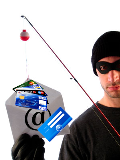This article is all about Phish/Phishing and the things you need to know about them
 Phishing, short for phish, has been dramatically increasing over the years. It’s a very dangerous thing and must be avoided at all cost.
Phishing, short for phish, has been dramatically increasing over the years. It’s a very dangerous thing and must be avoided at all cost.
But “Phishers” are smart and they usually victimize people who are not well informed about Phishing. Today I’ll share to you things that you need to know Phishing and how you can stop them.
Before I start on the details, let me share you this video of Lee and Sachi LeFever explaining and defining Phishing in plain English. This will give you an idea what is it all about.
Now that you have an idea about what phishing is, let’s get down into more details. As you have seen in the video above, it usually occurs in emails. So how do you stop phishing from emails? Basically you need spam filters or anti phish/phishing programs or software.
There are spam filter service providers that offers solution to your phishing problems. Google has it’s own Gmail spam filter for unwanted emails, spams and for phising protection.

You need to also understand that Phishers also target social networking sites like Facebook, they call it social phishing. In Social Phishing, instead of getting information from your email, they use social networking sites to get information. Be very careful at what you click.
How to stop phishing on Facebook and other social networking sites you might ask? Simple, just do not click suspicious links or offers. And do not give sensitive information to sites that you are not sure of. Always check the URL or Web Address to see if it looks suspicious.

There are also Phish sites, where people “impersonates” a site, like Facebook, Gmail, Paypal and others, and take sensitive information like your username and password when, blindly, login to Phish sites.
So how to avoid phishing sites? Again the solution is simple. Check the URL or web address of the web site. For websites that gets sensitive information from you, they usually start with https instead of http. HTTPS stands for Hypertext Transfer Protocol Secure. Also check if the URL is familiar or not. Like Paypal will always be paypal.com or Facebook will always be facebook.com.
When you stumble into a site that looks like Facebook, Paypal or your Bank’s web site and you see that the URL is somewhat different, leave or exit the page immediately.

There are phishing filters for Firefox and phishing filters for IE8 that could help you stop from accessing unwanted and suspicious sites.
You might be wondering what’s the difference between Phishing and Identity Theft, right?
Phishing is technically different from identity theft. Identity theft is when someone uses your personal information to impersonate or pretend that he/she is “you” and use it to that person’s advantage. Whereas in Phishing, the person takes your username, passwords and or other sensitive data so that they could steal something from you using the information they phished out from you. Although phishing may also result in identity theft.
I hope this simple phishing protection tips would help. Always remember to avoid suspicious sites and links. It’s a nasty jungle out there!
If you like this article please do consider sharing it to your network.


Leave a Reply